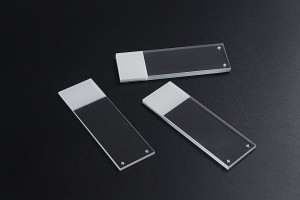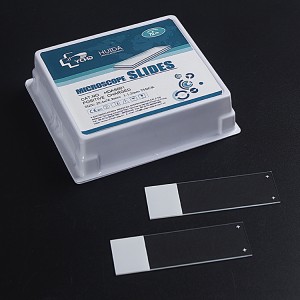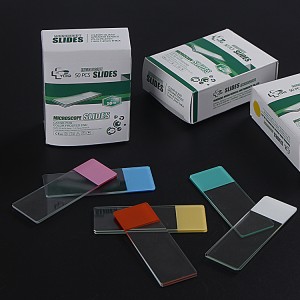Why Is The Microscope Slide Shining With A Blue Light
To understand why microscope glass slides produce a blue light when they are subjected to UV light, the parameters such as wavelength and intensity of this ultraviolet radiation, the properties that govern the optics of these materials, factors in its surroundings and how stable this slide is chemically must be taken into account. This article delves deeper into these issues to give an all-rounded point of view.
The significance of UV Wavelength and Intensity
UV light is made up of 200 nm to 400 nm wavelengths. Hence, when microscope glass slides are illuminated by Ultraviolet (UV) radiations it may emit blue light under certain conditions. Fluorescence results from a specific combination of chemical constituents or coatings within the slides which absorb ultra violet radiation before releasing it again in visible form.
1.Chemical Composition and Coatings: Some microscope glass slides are produced with inorganic phosphors or other chemicals that fluoresce under ultraviolet (UV) illumination. For example, a slide coated with substances like fluorescein or fluorophores will take up UV radiation and give off visible blue light.
2.UV intensity: Enhanced fluorescence effect can be obtained by increasing the intensity of UV radiation. Where fluorescence microscopy has been set up for use in laboratory situations, powerful sources of ultra violet light provide good examples by magnifying blue light emissions on a glass slide placed under a microscope.
Optical properties
Materials used for making microscope glass slide such as quartz or special optical glasses greatly influence their interaction with ultra violet light.
1.Material selection: For instance, quartz slides have high transparency towards UV rays hence commonly chosen for use in fluorescence microscopy due to low autofluorescence. On the contrary standard glass slides could show differing extent of fluorescence contingent on purity levels inherent and any added coatings therein.
2.Surface treatments: A typical illustration among several others manipulations done on glass slide characteristics at oil coating level inside laboratory includes; use oil coatings which modify them so as to maximize absorption of UV radiation and improve contrast by reducing light scattering. They also affect the fluorescence of the slides under UV light.
Environmental Factors
Environmental factors such as ambient lights and others have significant effects when using microscope glass slide.
1.Interference from competing light sources: The observed UV-induced fluorescence can be interfered with by natural sunlight or artificial lights like LEDs, fluorescent lamps etc. Notably blue light is part of visible spectrum that could mix up with the emitted one to enhance or mask the observed fluorescence.
2.Laboratory conditions: The presence of temperature variations, humidity levels and chemical contaminants in the vicinity of this slide can alter its optical performance. It has been shown that, for instance high temperature changes may affect the intensity of fluorescence while impurities containing molecules can quell this process or even lead to additional emissions.
Chemical stability of slides
UV illuminated microscope glass slides undergo chemical degradation which alters their optical properties.
1.Chemical Reactions: Slides tend to undergo a number of chemical changes on their surfaces upon exposure to UV radiation over an extended period. Examples include where organic impurities completely decompose into simple products as well as when coatings break down thus altering their fluorescence capabilities among others.
2.New Compounds: Another possibility regarding these changes is that new compounds are formed through photochemical reactions under UV illumination; hence they generate varying kinds of fluorescents. These variations could change how a given glass slide looks on a microscope stage thereby increasing or modifying blue emission values therefrom.
Factors Favoring Blue Light Emission
Under UV illumination, blue light is more likely to be emitted by microscope glass slides in the situations below:
1.Presence of Fluorescent Chemicals: Slides made up or coated with substances that absorb UV light and emit blue light are prone to fluorescence. These could include particular dyes, stains, or phosphorescent materials.
2.Optical Enhancements: Materials and surface treatments that boost the efficiency of both UV absorption and emission will increase the chances for a blue light emission. For instance, slides which have AR coatings can enhance the fluorescent signals.
3.Environmental Interference: The presence of ambient blue-light may enhance perceived fluorescence thereby making the blue emission more noticeable.
Applications Practical And Observations
This has many practical applications and implications in laboratory settings where ultraviolet light makes glass microscope slides emit blue lights:
1.Fluorescence Microscopy: This technique relies on the fact that fluorescently labeled samples emit light. Understanding how different conditions amplify fluorescence can improve image quality and accuracy.
2.Slide Preparation: In order for them to function optimally under UV lighting; it is important to prepare laboratory glass slides using appropriate fluorescent staining as well as treatment methods. Consistency in quality control and minimization of contaminants is very important.
3.Equipment Calibration: Regular calibration of microscopes and UV light sources ensures reliable and reproducible fluorescence measurements. Proper alignment and intensity settings are critical for accurate observations.
Conclusion
In conclusion, there are several factors affecting emission of blue color from microscope glass slides illuminated by Ultraviolet (UV) rays such as wavelength & intensity of UV radiation, slide material’s optical properties, environmental conditions, chemical stability of slides etc. Knowing these aspects is essential for optimizing use preparation though they are used differently in various laboratories around the world because some knowledge on this helps to optimize fluorescence microscopy while ensuring such is based on establishing how reliable these facilities tend to be when researchers make observations within their labs thereby making one’s work credible.
When all these factors are exhaustively dealt with, researchers and lab technicians should be able to improve on the performance of glass slides inside microscopes resulting into more precise and interesting scientific findings.
Reference
Post time:2024-08-02







